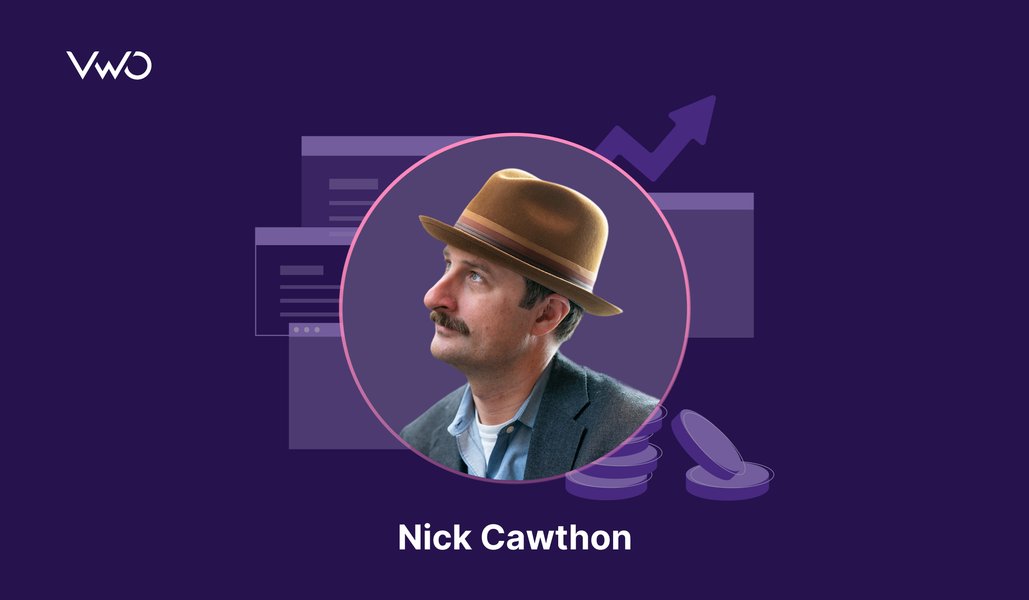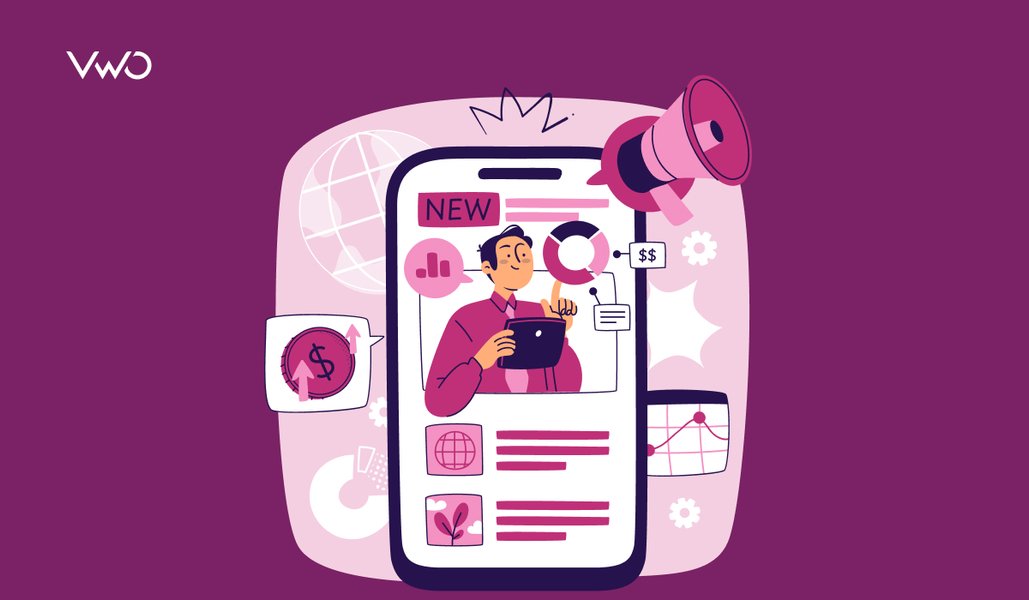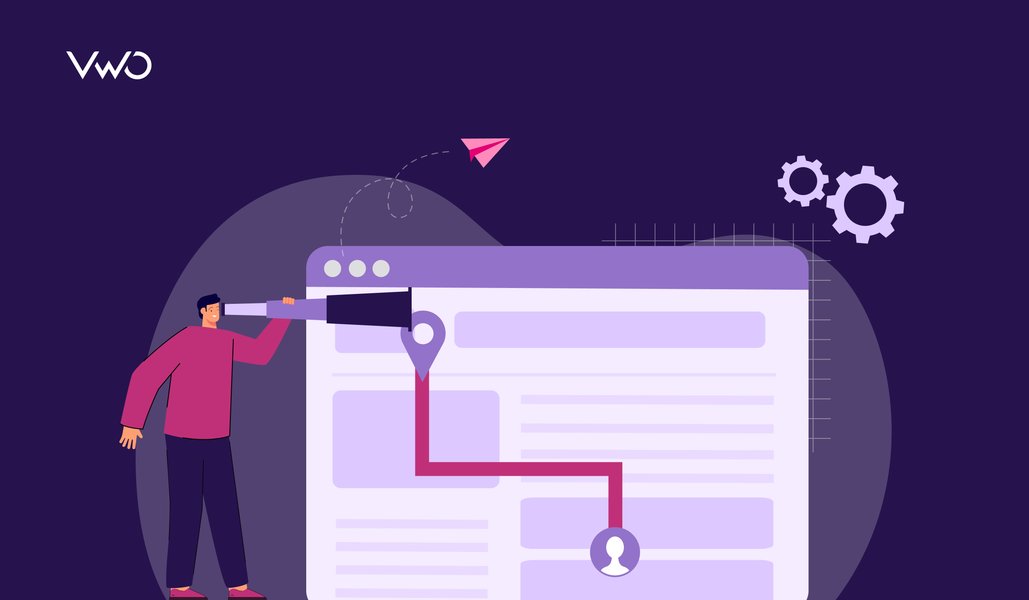Marketing automation has taken the business world storm, becoming an absolute sensation.
Do you wonder, though, why you should bother with automation when you can handle most of the tasks manually? Well, in today’s digital-first world, where speed and efficiency are highly sought after, manually handling your marketing campaigns can hold your business back from reaching its true potential. You don’t want to be left behind by your competitors who are embracing marketing automation to scale their businesses.
Download Free: A/B Testing Guide
It is high time you say goodbye to mind-numbing repetitive tasks and deep dive into marketing automation. In this blog, we tell you how to use marketing automation so that you can derive the right kind of value for your business to succeed.
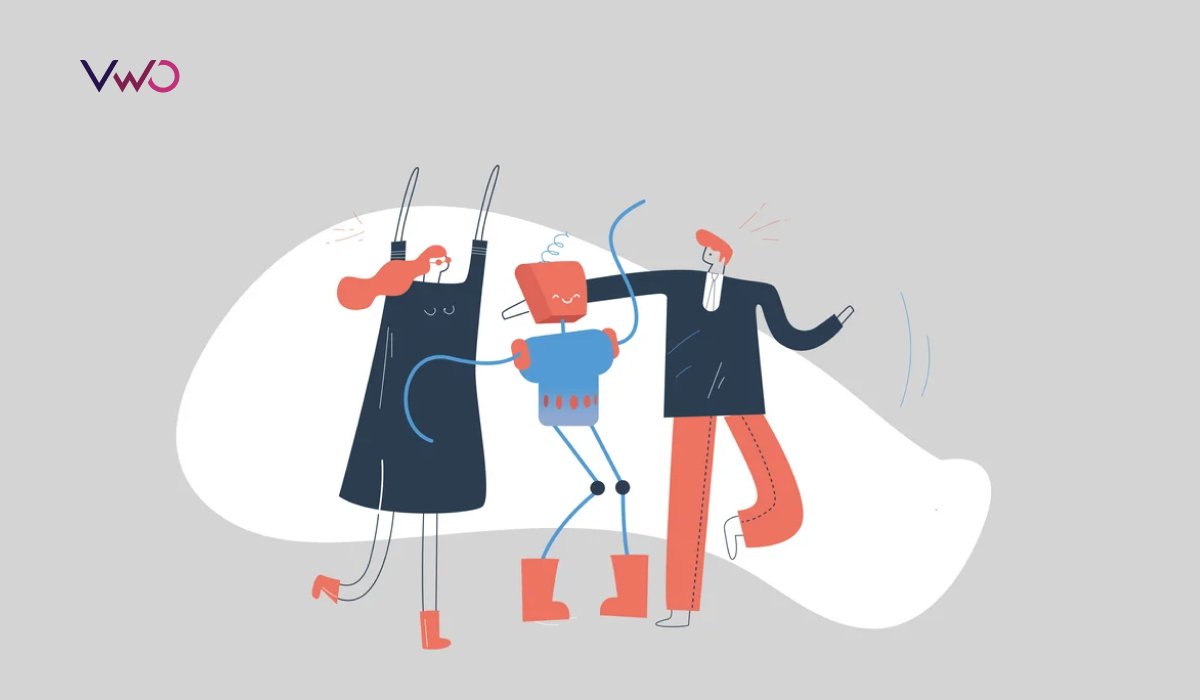
How does marketing automation work?
Marketing automation comprises a range of tools that makes the lives of marketers easier by streamlining and taking the complexities out of time-consuming repetitive marketing tasks.
Let’s understand how it works with an example. Suppose you own an online fashion store and you set up an automatic email campaign that gets triggered when a visitor signs up for your newsletter. Through this email, you can welcome the visitor to your website and offer some discounts to encourage them to purchase and push them down the shopping funnel.
This is just one example of how you can leverage marketing automation to engage your customers. With automated marketing, you can enhance your email and social campaigns by integrating mobile messaging using SMS, send push notifications, send group messages, and display digital ads to targeted audiences, and lots more.
Marketing automation is done for two primary reasons—to enhance marketing and sales teams’ efficiency and output, and enrich customer experience through efficient engagement.
Today, our machines can sift through billions and trillions of bits of data within seconds. Marketing automation platforms and technologies have an almost infinite ability to comprehend information and target existing or potential customers with automated messages across email, web, and social media.
Why is marketing automation important?
From email marketing and social media marketing to ad campaigns and push notifications; marketing automation is increasingly being used to automate and streamline everyday marketing processes. Other than that, automated marketing also tracks and analyzes customers’ online behavior and buying patterns. This can then be used to segment target audiences and then deliver personalized messaging. Let us look at some benefits that marketing automation brings to your business.
Personalized customer experience
By capturing the right data from your marketing channels that help you analyze your customer behavior, marketing automation lets you create tailored messaging for audiences across several channels. It is all about delivering the right content at the right time, in the right place, and in the way your audiences prefer based on the data points from their online behavior. Customers love receiving personalized messages, like special birthday discounts, which make them feel valued and more likely to return to your brand for more.
Enhanced efficiency and creativity
Your team doesn’t have to focus on mundane tasks that are already scheduled to be executed by a marketing automation platform. They can direct all their attention to coming up with more creative marketing ideas which, in turn, boosts your team’s efficiency and delivers better output. This streamlining of work processes helps you provide a unified customer experience that starts from the very first interaction and continues long after purchases.
Improved customer retention
You can trust automated marketing tools to provide a seamless customer experience by connecting with buyers via multiple channels throughout their buying journey and keeping them engaged with meaningful content. And if a customer has a great experience buying from you, they are more likely to stick around and turn into brand loyalists. You would definitely want to retain your existing customers and increase customer lifetime value to avoid spending a fortune on acquiring new customers.
Prompt customer service
Marketing automation helps you improve customer service by speeding up response times to customer inquiries. By leveraging behavioral data stored in customer relationship management (CRM) systems, you gain a clear understanding of each customer’s history, enabling you to deliver tailored and relevant support without delay. Automation of responses is based on previous purchases, in-product actions, demographic information, and personal preferences to provide users with a seamless experience across all touchpoints.
6 Types of marketing automation
Find below the types of automation you must implement to get the best results out of your marketing efforts.
Email marketing automation
Automating email campaigns lets you send personalized emails based on customer behavior and segmentation. For instance, if a customer leaves their shopping cart without buying, an automated email can be sent to remind them that they have items in the cart that they can buy at a discount price within a specific time. Some popular email marketing automation tools include HubSpot, Mailchimp, and Campaign Monitor.
Social media marketing automation
Social media marketing automation facilitates automated posting, scheduling, and monitoring of posts across several social media platforms. Imagine, you wish to schedule a social media post to be published at a specific time in a different time zone, but you are not available to work during that time. In such cases, you schedule a post in advance and have it automatically published at optimal times.
Customer relationship management automation
CRM automation streamlines and integrates marketing and sales efforts by automating lead management, customer segmentation, and tracking customer interactions. Through these platforms, you can nurture prospects and cultivate strong customer relationships. Salesforce and HubSpot CRM let you monitor customer interactions across diverse channels and send tailored follow-up emails based on customer behavior.
Content marketing automation
You can automate the creation, distribution, and analysis of content to free up resources and invest them in marketing tasks that require decision-making. Optimization of content strategies and tracking engagement metrics are also possible with content marketing automation tools. Tools like Kapost and CoSchedule help streamline content development by assigning tasks, scheduling publications, and offering analytics to measure content performance.
Omni-channel marketing automation
Omnichannel marketing automation enables you to optimize customer engagement, nurture leads, and bring conversions by providing a unified and personalized customer experience across all touchpoints in their journey with your brand. Let’s take Adobe Campaign or Salesforce Marketing Cloud Account Engagement as examples. They allow you to automate personalized email campaigns, social media ads, and even website pop-ups to ensure an integrated customer journey across different channels.
Advertising automation
Advertising automation streamlines and optimizes campaigns by automating tasks like ad creation, targeting, bidding, and optimization. For example, when you have a visitor on your product page, advertising automation will show them ads for your product on the website they visit next. For instance, Google Ads provides automation features like Smart Bidding for optimizing bids for conversions and offers responsive search ads that adapt to users’ search queries.
Where to Use Marketing Automation?
Let’s look at a few tasks that you can automate and maximize your marketing efforts:
Welcome messages
So, a visitor has just opted for your product/service. What do you do next? How do you keep the communication going? Sending an automated yet personalized “Welcome on board” message/email is a great way to immediately engage with a visitor who has just converted to a customer or subscriber. The welcome message could ask them about their interests to give them relevant updates, talk about what you as a business have on offer, or simply help them get started.
For instance, let’s look at the email you receive from Netflix as soon as you purchase a plan:
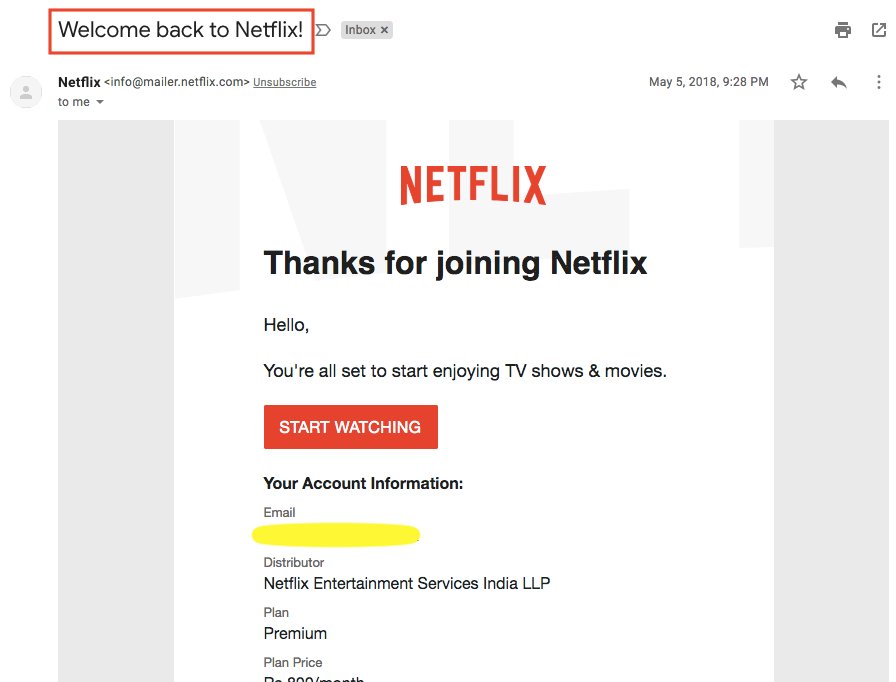
Offers on special occasions
As a marketer, you need to stay relevant in your customers’ lives, and a great way to do that is by leveraging birthdays, anniversaries, and local festivals to offer special discounts and deals. Moreover, with the help of such campaigns, you also get to build better customer relationships.
One great way to do this is by scheduling notifications for later so you never miss out on an opportunity. On the date set beforehand, your message will be delivered to your customer. By doing this, not only will you observe increased customer engagement with your business, but also better brand awareness and recall.
Take a look at the push notification sent by Macy’s for Black Friday sale:

Take a look at the push notification sent by Macy’s for Black Friday sale:
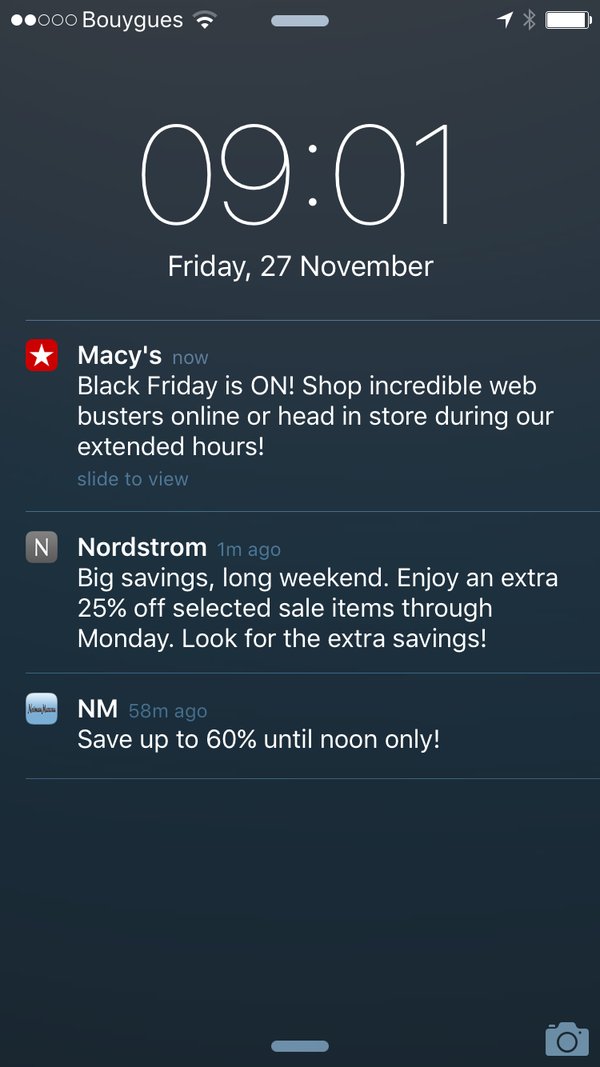
Notifications
To ensure your subscribers are always up-to-date with your blog and also keen to find out what’s new, you can automate new post updates to subscribers. This can be implemented in two ways:
RSS-to-Push:
RSS-to-Push sends a push notification to your blog subscribers the moment it detects a new post. The blog title is taken as the heading of the notification, and the first 48 characters of the body become the notification message. You can, of course, edit the details and schedule the notification for later. This method is effective as the push message appears on your users’ device screens as clickable messages, tempting them to click on it. This way, you’ll find more engaged readers.
Here’s an example of the same:
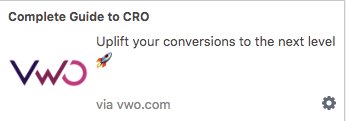
Automate emails:
You can automate sending blog post updates via email to your readers, similar to RSS-to-Push. But the results will vary here as emails are not as agile as Push Messages. They could lay unopened for a long duration or land in spam folders in subscribers’ inboxes. Whereas, pushes appear instantly on device screens.
Here’s an example of an automated email from Adweek:
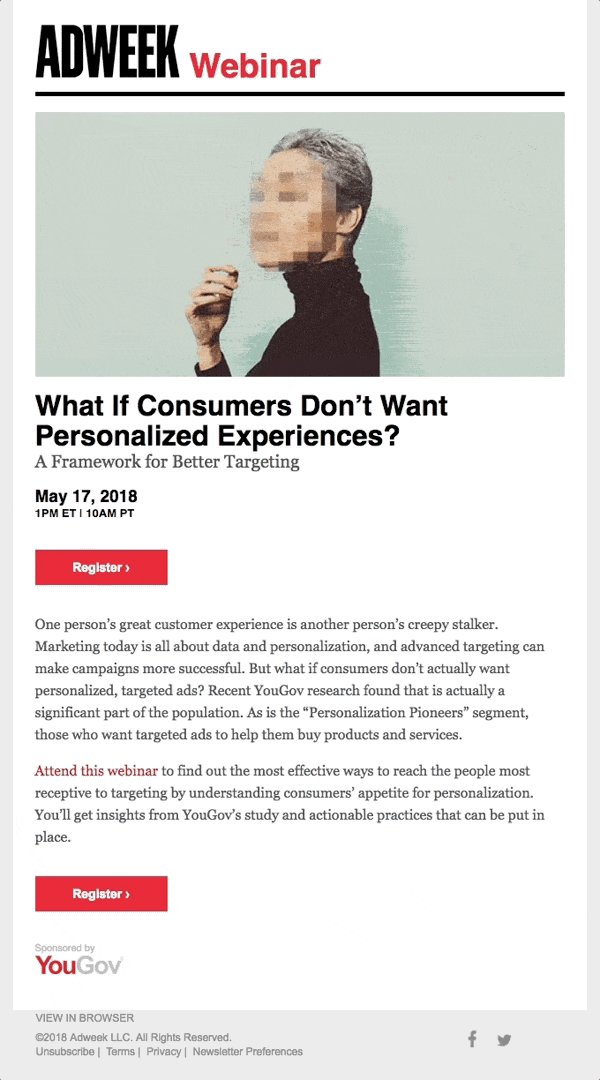
Reminder messages
If your business attends, organizes, hosts, or even informs users about events, it would be beneficial to automate reminder messages instead of doing it manually. Be it an invitation, pre-event, or post-event message; sending reminders at the right time is a great way to engage with them. You could plan in advance how you’d want to go about these messages.
For instance, you can schedule an invitation, giving brief details about the event, followed by a reminder message and then a confirmation request. Based on those who did finally attend the event, you can then schedule a post-event message, a survey, or even arrange a call with your sales team.

Customer support
In today’s day and age, one of the biggest ways you can disappoint your customer is by making them wait. Be it customer service, shopping, or navigation; chatbots have revolutionized the way brands communicate with users but minimizing their wait time. Chatbots save time and give better results as part of your marketing automation strategy. Because robots don’t get exhausted or irritated with never-ending queries, they can meticulously look at what’s being asked of them and respond accordingly.
Marketers and customer service agents can be relieved of having to look at their overflowing inboxes or having to perform daunting tasks. This is a great medium to communicate effortlessly.
Here’s a look at Sephora’s chatbot and how it assists visitors:
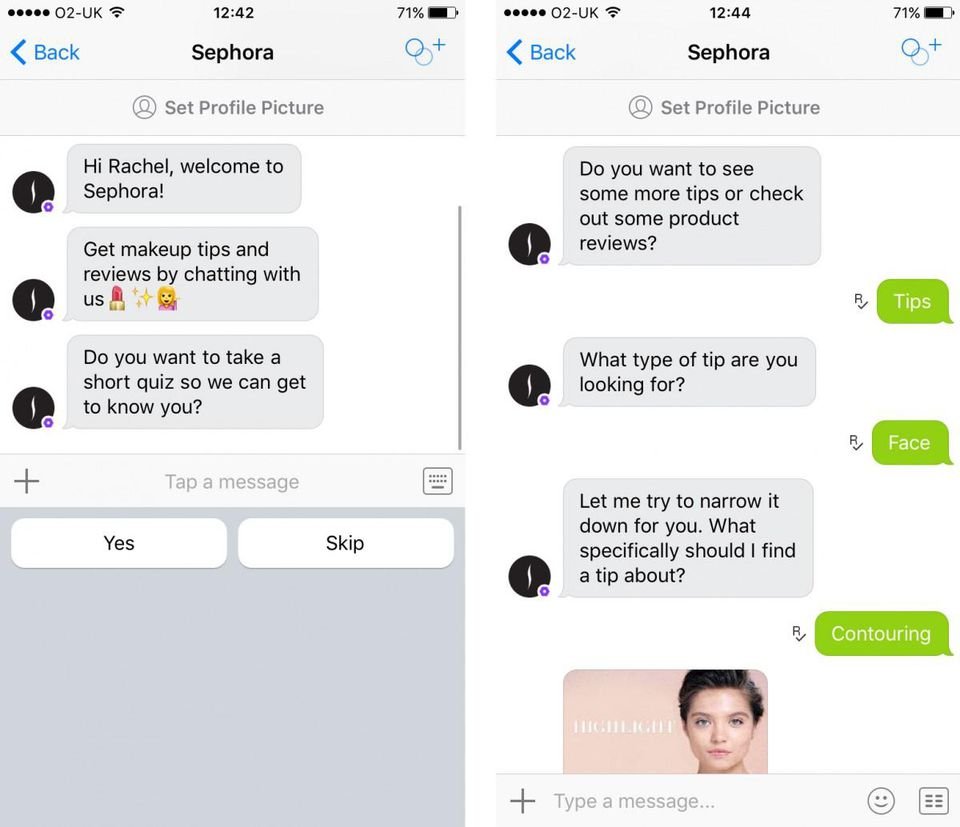
These were just a few of the abundant tasks being automated by marketers these days. However, the rapid rise of marketing automation begs the question—Will marketing automation replace human creativity?
Every time you upload a post, picture, or a tweet, a machine is memorizing them and inferring your personality and characteristics!
The pace at which marketing automation is making use of technologies such as artificial intelligence and machine learning to build businesses of the future is truly fascinating. From offering customized content and delivering personalized recommendations to providing human-like assistance via chatbots; AI happens to be one of the key pillars in defining a solid marketing automation strategy. And why wouldn’t it?
Combining artificial intelligence with automation marketing helps marketers truly supercharge their marketing efforts by providing a better customer experience, increasing their efficiency, putting out more relevant content, and driving business growth.
However, doesn’t it make you wonder about the endless possibilities that come with technology? With all the advancements, one daunting concern is that technology will take over jobs and potentially win in the hypothetical “human vs. machine” battle.
Download Free: A/B Testing Guide
Problems with Marketing Automation
While marketing automation offers several benefits for your business, it is important to stay aware of the potential problem you may encounter in trying to adopt the new automation process.
Complex learning curve
When incorporating a marketing automation tool in your workflow, it is important to be prepared for a learning curve ahead. In fact, some platforms may present a steeper learning curve than others, given their more advanced features. For all such reasons, some of your team members can even resist adopting the new automation process, resulting in reduced effectiveness and slower adoption.
Lack of human intervention
Even if the automation platform handles repetitive tasks, human intervention is still essential to leverage its capabilities and achieve desired outcomes. You must plan strategically, set goals, and analyze campaign performance. Over-reliance on automation can derail your marketing strategy and hamper your end goals. For instance, sending auto-generated responses to customer inquiries is not enough sometimes. Human intervention may be required to get on a call with them to understand their needs better.
High expenses
Marketing automation platforms can be an expensive investment for small businesses with limited budgets. Apart from the initial purchase, there are additional expenses to consider like customization, integration, technical support, ongoing maintenance, and training employees to use the platform effectively. If yours is a small business, you must evaluate the return on investment (ROI) to make sure the benefits outweigh the expenses.
Top marketing automation tools to choose from
HubSpot
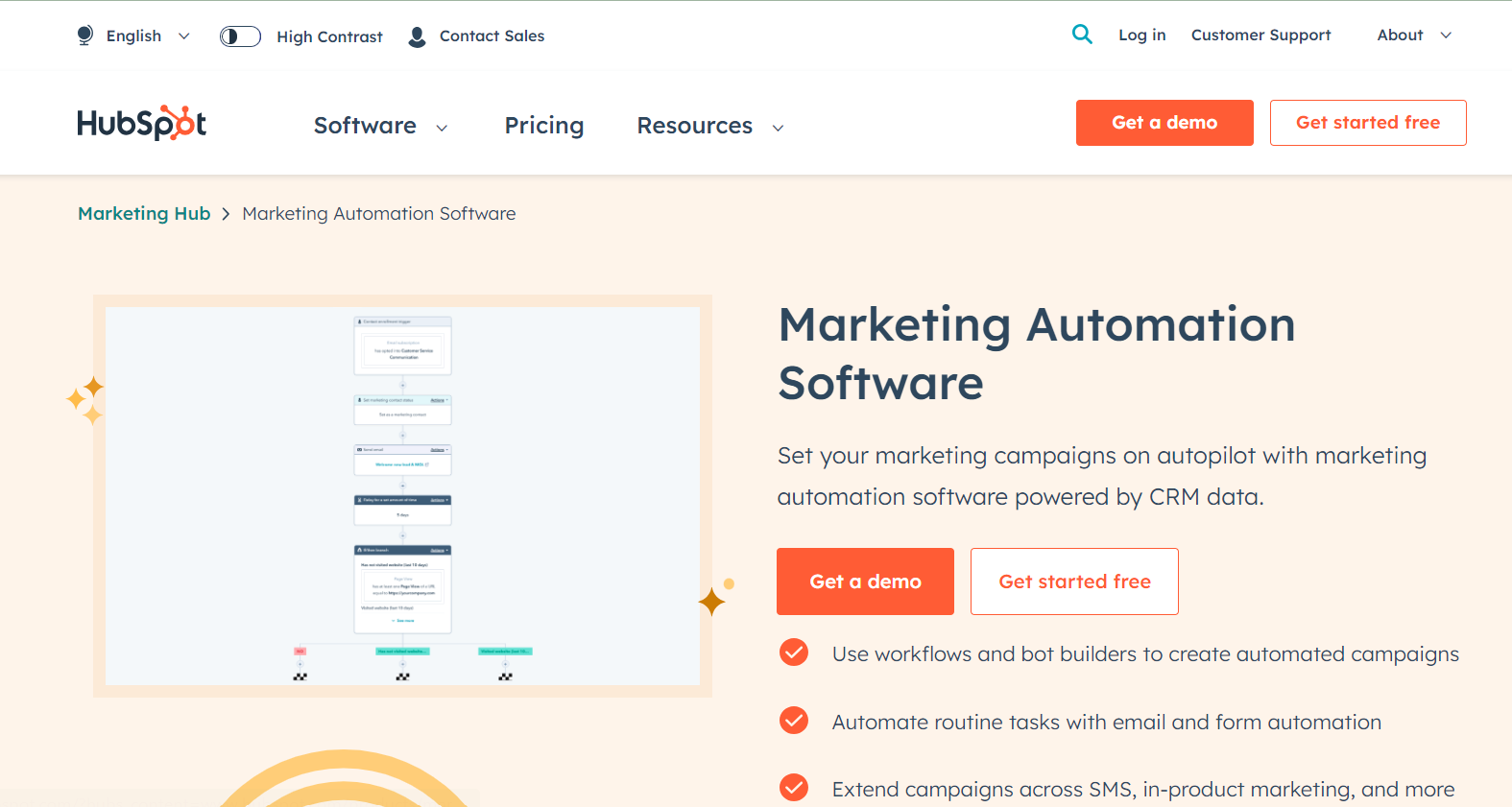
HubSpot offers a comprehensive growth suite that integrates sales, marketing, and support software with their CRM. This integration unlocks numerous automation possibilities that would be challenging with separate tools. HubSpot’s automation marketing functionality includes a user-friendly visual board for creating simple or advanced workflows. Using HubSpot, you can easily set up automated email responses for your contact lists, create advanced rules to deliver personalized emails, support live chat interactions, and much more.
Salesforce Marketing Cloud Account Engagement
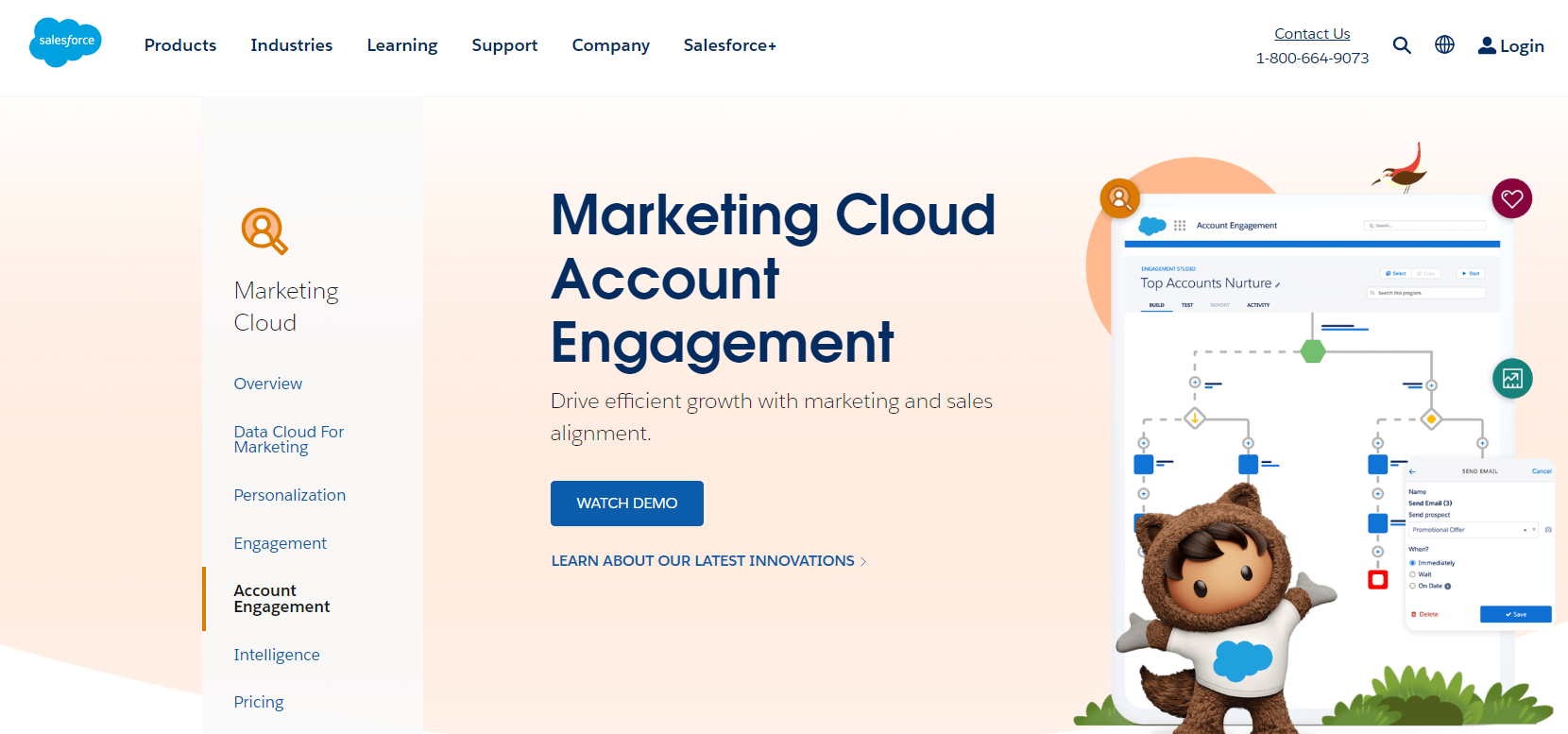
Salesforce Marketing Cloud Account Engagement is a comprehensive cloud marketing automation solution designed for enterprise clients with technical resources. It offers a range of features starting from CRM integration and email marketing to lead nurturing and ROI reporting to power your campaigns for maximum results. The platform also enables tracking website interactions and building predictive lead scoring for marketing efficiency.
Adobe Marketo
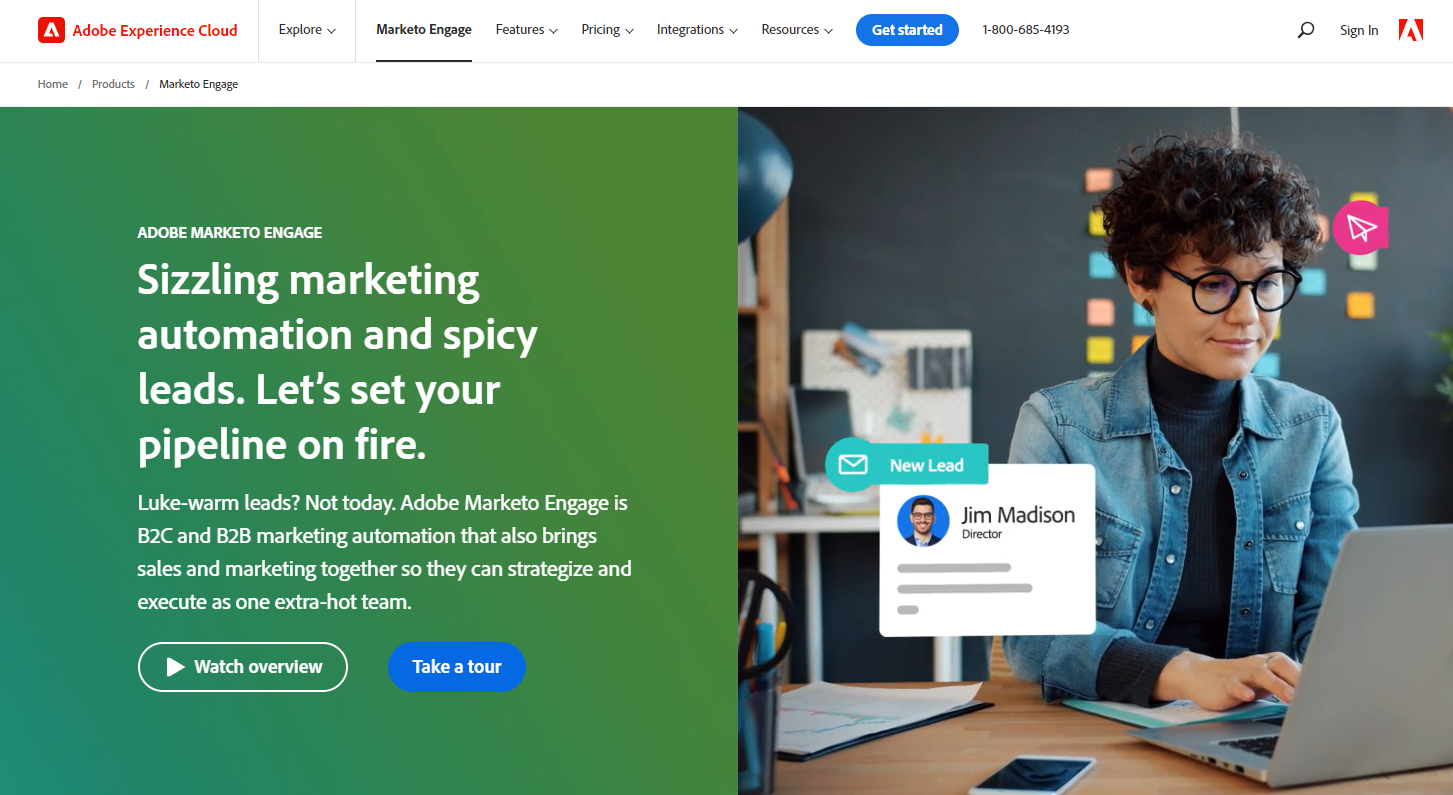
Adobe Marketo Engage is a marketing automation software that enables customer-driven journeys across multiple channels. From emails to landing pages, Marketo Engage leverages user profiles, AI, and real-time behavioral data to personalize experiences for all users. It integrates with CRM systems and supports advanced lead generation, scoring, and account management. Further, you can track content effectiveness, analyze customer journeys, and connect sales and marketing teams for better marketing efficiencies.
ActiveCampaign
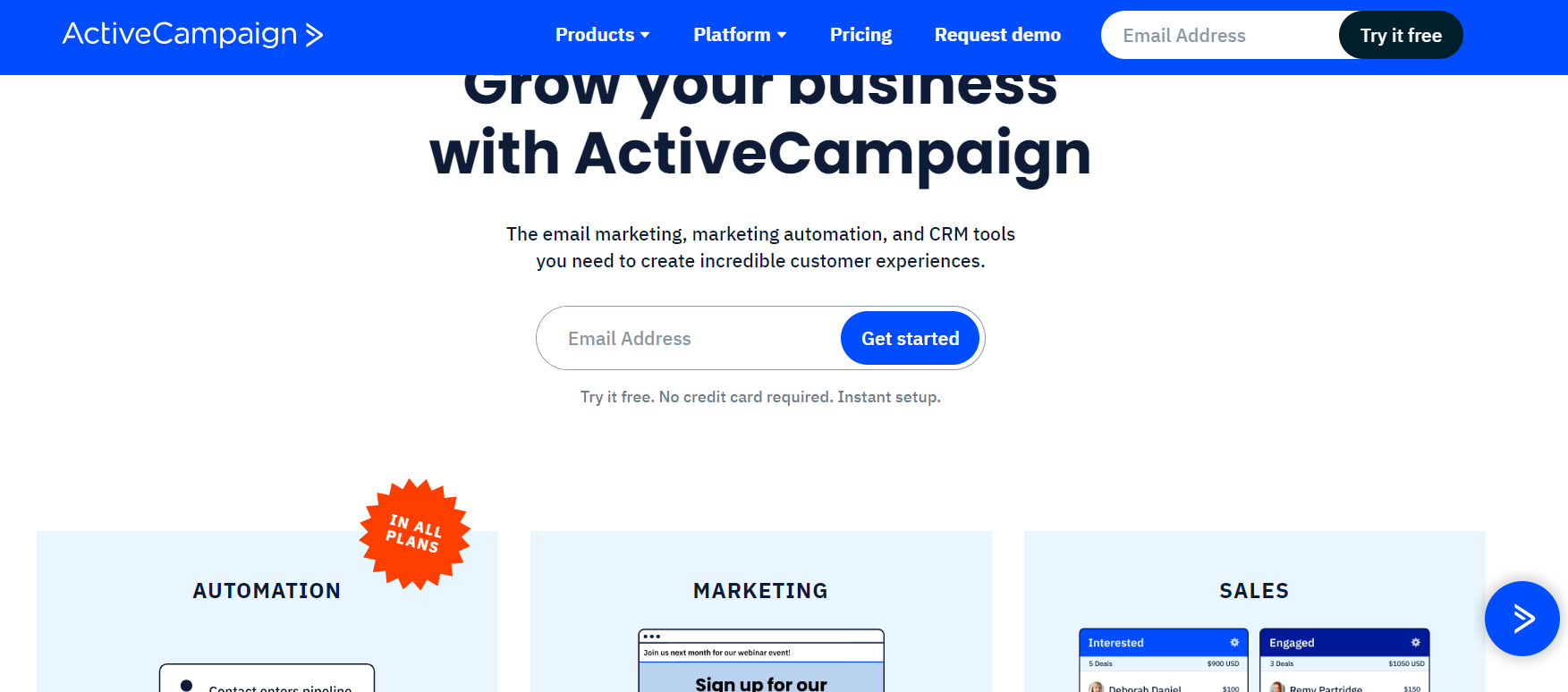
ActiveCampaign is a comprehensive platform combining email marketing, automation, sales software, and CRM capabilities. You can automate tasks, manage customer relationships, and execute effective email marketing campaigns. With its cloud-based marketing automation solution, you can create personalized campaigns using detailed behavior tracking and marketing segmentation. The platform also provides features like lead scoring, web analytics, and customer relationship management to enhance marketing and sales processes.
MailChimp
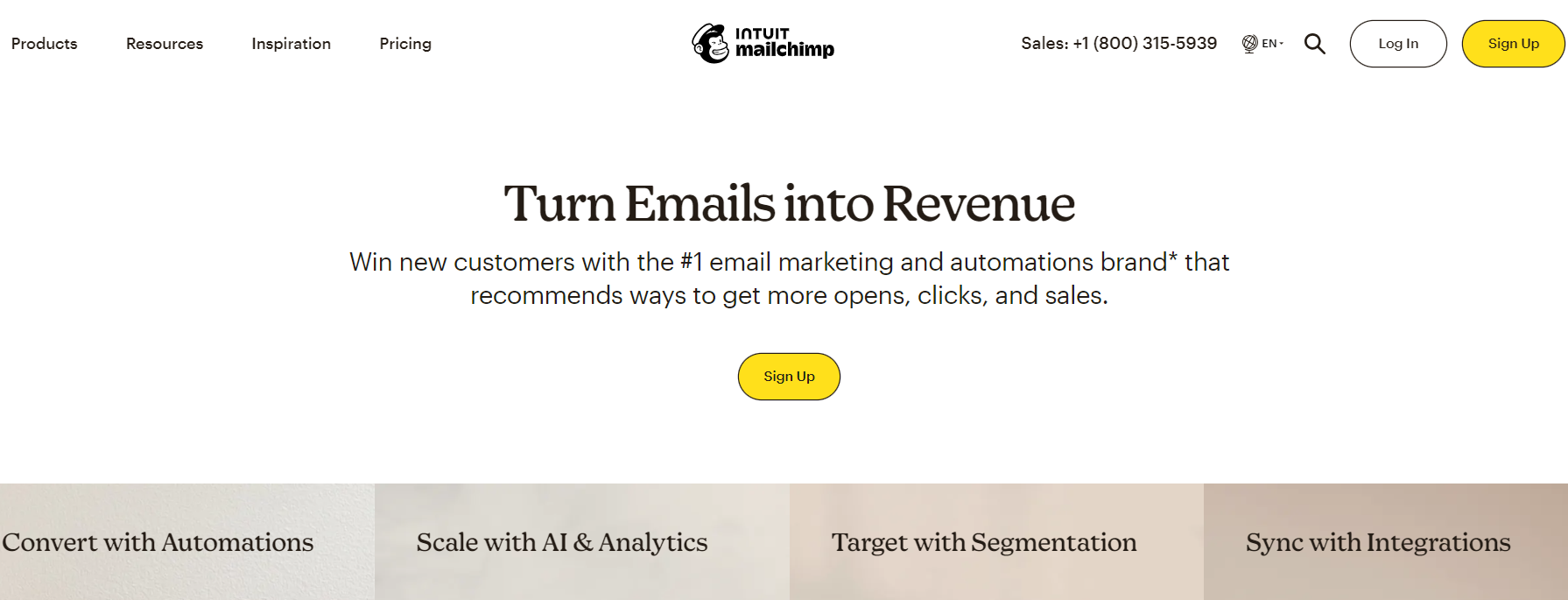
MailChimp allows you to automate email series, personalize customer journeys, and trigger actions based on customer behavior or specific events. By understanding your audience and their interests, you can reach contacts at any stage of the customer journey and personalize every email to make recipients feel valued. Its user-friendly interface provides various features to effortlessly engage with your audience, including optimizing email timing and leveraging eCommerce automation.
Finding the right balance
We have established that marketing automation has reached unexplored tangents. However, we need to admit that this automation doesn’t market for you; it only helps you maximize your efforts. It is the utility knife of really cool things. But like any utility knife, it is only helpful if you know how to use it.
Marketing automation is here to enhance our performance with minimal effort, and do the dull and complicated work for us, allowing us to focus on marketing as an art.
Since data sets are rapidly expanding, with machine intelligence, we can act upon them instantaneously. Today we’re incapacitated by the extensiveness of data, which is humanly impossible to process without technology. Although many consider the technological evolution as an existential threat, and the ‘AI Apocalypse’ is a hot subject of debate, with extensive data comes great power. What humans do with this power will change the face of marketing.

Frequently asked questions
Marketing automation refers to the use of a set of tools that automate repetitive tasks so that businesses can save time, improve efficiency, and deliver targeted messages to audiences at the right time. By embracing automation, it gets easier for marketers to track customer interactions, measure the effectiveness of campaigns, and enhance the overall customer engagement strategy.
Marketing automation can be used to set up email drip campaigns. For example, when anyone signs up for a newsletter, they receive a welcome email immediately, followed by a series of emails with a lot of information over the next few weeks. This helps you nurture leads and build relationships with them to encourage them to engage with your brand even more. Read relevant sections of this article and learn how to use marketing automation in various ways.
Lead nurturing – By setting automated email and ad campaigns, you can offer personalized content to your prospects, educating them about your products or services and ultimately motivating them to convert into customers.
Personalized experiences – Marketing automation platforms track customer behavior across touchpoints, be it website, email, or social media, to create personalized experiences. Personalized content, recommendations, and offers based on preferences and actions enhance the customer experience, leading to higher engagement and conversions.
Customer retention – Automated campaigns sending out personalized emails, offers, or rewards based on customer behavior, such as previous purchases or online interactions, can make customers feel valued and flattered. By staying connected with customers and delivering the right content at the right time, businesses can increase customer loyalty and encourage repeat purchases.
CRM software and marketing automation software have different purposes. CRM software is mainly used for sales, while marketing automation is primarily used for marketing. However, they can work in tandem with marketing automation software to help you get the best result out of your marketing efforts. For example, your CRM can transfer demographic data to your marketing automation platform, which can then be used in your marketing campaign to personalize messages or run paid advertisements. This may be called CRM automation as mentioned earlier in types of marketing automations.
Firstly, you must assess your current marketing processes and understand what areas can benefit from automation. Do you want to automate email campaigns, lead nurturing, or social media scheduling? Figure out the answer. Secondly, select a marketing automation solution aligning with your budget, and business requirements, and fits in well with your existing tools and systems. Next, create a marketing strategy using your automated campaigns where you set goals you want to achieve and relevant workflows. Finally, continuous monitoring of your metrics to see if automation has impacted them in the desired way.
With so many options available today, it’s a bit challenging to set your hands on the right automation platform for your business. Here are some points you can consider when choosing such a tool.
1. Understand your budgetary constraints and specific requirements of your business to find a platform that fits your budget and goals.
2. Look for an automation tool that is easy to use so that the learning curve is not as steep and your team can quickly adapt and make the most of it.
3. Ensure the marketing automation software provides analytics and reporting tools to track the performance of your campaigns and measure metrics important to your business.
Check if the platform is integrable with others tools in your existing martech stack to streamline marketing campaigns and maximize outcomes from them.



